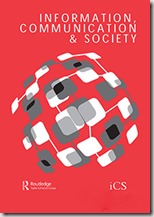Home » Posts tagged 'ultrasound'
Tag Archives: ultrasound
Two New ARticles
Two new articles …
 [X] Visualising the Ends of Identity: Pre-Birth and Post-Death on Instagram in Information, Communication and Society by me and Tim Highfield. This is one of the first Ends of Identity article coming from our big Instagram dataset, analysing the first year (2014). We’ll be writing more looking at the three years we collected (14-16) before the Instagram APIs changed and locked us out! Here’s the abstract:
[X] Visualising the Ends of Identity: Pre-Birth and Post-Death on Instagram in Information, Communication and Society by me and Tim Highfield. This is one of the first Ends of Identity article coming from our big Instagram dataset, analysing the first year (2014). We’ll be writing more looking at the three years we collected (14-16) before the Instagram APIs changed and locked us out! Here’s the abstract:
This paper examines two ‘ends’ of identity online – birth and death – through the analytical lens of specific hashtags on the Instagram platform. These ends are examined in tandem in an attempt to surface commonalities in the way that individuals use visual social media when sharing information about other people. A range of emerging norms in digital discourses about birth and death are uncovered, and it is significant that in both cases the individuals being talked about cannot reply for themselves. Issues of agency in representation therefore frame the analysis. After sorting through a number of entry points, images and videos with the #ultrasound and #funeral hashtags were tracked for three months in 2014. Ultrasound images and videos on Instagram revealed a range of communication and representation strategies, most highlighting social experiences and emotional peaks. There are, however, also significant privacy issues as a significant proportion of public accounts share personally identifiable metadata about the mother and unborn child, although these issue are not apparent in relation to funeral images. Unlike other social media platforms, grief on Instagram is found to be more about personal expressions of loss rather than affording spaces of collective commemoration. A range of related practices and themes, such as commerce and humour, were also documented as a part of the spectrum of activity on the Instagram platform. Norms specific to each collection emerged from this analysis, which are then compared to document research about other social media platforms, especially Facebook.
You can read the paper online here, or if the paywall gets in your way there’s a pre-print available via Academia.edu.

[X] Instagrammatics and digital methods: studying visual social media, from selfies and GIFs to memes and emoji in Communication, Research and Practice, also authored by Tim Highfield and me. This paper came out earlier in the year, but I forgot to mention it here. The abstract:
Visual content is a critical component of everyday social media, on platforms explicitly framed around the visual (Instagram and Vine), on those offering a mix of text and images in myriad forms (Facebook, Twitter, and Tumblr), and in apps and profiles where visual presentation and provision of information are important considerations. However, despite being so prominent in forms such as selfies, looping media, infographics, memes, online videos, and more, sociocultural research into the visual as a central component of online communication has lagged behind the analysis of popular, predominantly text-driven social media. This paper underlines the increasing importance of visual elements to digital, social, and mobile media within everyday life, addressing the significant research gap in methods for tracking, analysing, and understanding visual social media as both image-based and intertextual content. In this paper, we build on our previous methodological considerations of Instagram in isolation to examine further questions, challenges, and benefits of studying visual social media more broadly, including methodological and ethical considerations. Our discussion is intended as a rallying cry and provocation for further research into visual (and textual and mixed) social media content, practices, and cultures, mindful of both the specificities of each form, but also, and importantly, the ongoing dialogues and interrelations between them as communication forms.
This paper is free to read online until at least the end of 2016, but if a paywall comes up, there’s a pre-print of this one of Academia.edu, too.
Born Digital? Presence, Privacy, and Intimate Surveillance
 I’m pleased to note that my chapter ‘Born Digital? Presence, Privacy, and Intimate Surveillance’ is out now in the Re-Orientation: Trans-lingual, Trans-cultural, Trans-media. Studies in narrative, language, identity, and knowledge collection edited by John Hartley and Weiguo Qu for Fudan University Press. The collection is the outcome of the fantastic Culture+8: New Times, New Zones symposium in 2014 which explored cultural synergies between different countries and locations in the +8 timezone which include Perth where we hosted the event, and, of course, China.
I’m pleased to note that my chapter ‘Born Digital? Presence, Privacy, and Intimate Surveillance’ is out now in the Re-Orientation: Trans-lingual, Trans-cultural, Trans-media. Studies in narrative, language, identity, and knowledge collection edited by John Hartley and Weiguo Qu for Fudan University Press. The collection is the outcome of the fantastic Culture+8: New Times, New Zones symposium in 2014 which explored cultural synergies between different countries and locations in the +8 timezone which include Perth where we hosted the event, and, of course, China.
My chapter is a key part of my Ends of Identity project; here I start to think about ‘intimate surveillance’ which is where parents and loved ones digitally document and survey their offspring, from sharing ultrasound photos to tracking newborn feeding and eating patterns. Intimate surveillance is a deliberately contradictory term: something done with the best of intentions but with possibly quite problematic outcomes. Here’s the full abstract:
The moment of birth was once the instant where parents and others first saw their child in the world, but with the advent of various imaging technologies, most notably the ultrasound, the first photos often precede birth (Lupton, 2013). In the past several decades, the question is no longer just when the first images are produced, but who should see them, via which, if any, communication platforms? Should sonograms (the ultrasound photos) be used to announce the impending arrival of a new person in the world? Moreover, while that question is ostensibly quite benign, it does usher in an era where parents and loved ones are, for the first years of life, the ones deciding what, if any, social media presence young people have before they’re in a position to start contributing to those decisions.
This chapter addresses this comparatively new online terrain, postulating the provocative term intimate surveillance, which deliberately turns surveillance on its head, begging the question whether sharing affectionately, and with the best of intentions, can or should be understood as a form of surveillance. Firstly, this chapter will examine the idea of co-creating online identities, touching on some of the standard ways of thinking about identity online, and then starting to look at how these approaches do and do not explicitly address the creation of identity for others, especially parents creating online identities for their kids. I will then review some ideas about surveillance and counter-surveillance with a view to situating these creative parental acts in terms of the kids and others being created. Finally, this chapter will explore several examples of parental monitoring, capturing and sharing of data and media about their children, using various mobile apps, contextualising these activities not with a moral finger-waving, but by surfacing specific questions and literacies which parents may need to develop in order to use these tools mindfully, and ensure decisions made about their children’s’ online presences are purposeful decisions.
The chapter can be read here.
Mapping the Ends of Identity on Instagram
At last week’s Australian and New Zealand Communication Association (ANZCA) conference at Swinburne University in Melbourne I gave a new paper by myself and Tim Highfield entitled ‘Mapping the Ends of Identity on Instagram’. The slides, abstract, and audio recording of the talk are below:
While many studies explore the way that individuals represent themselves online, a less studied but equally important question is the way that individuals who cannot represent themselves are portrayed. This paper outlines an investigation into some of those individuals, exploring the ends of identity – birth and death – and the way the very young and deceased are portrayed via the popular mobile photo sharing app and platform Instagram. In order to explore visual representations of birth and death on Instagram, photos with four specific tags were tracked: #birth, #ultrasound, #funeral and #RIP. The data gathered included quantitative and qualitative material. On the quantitative front, metadata was aggregated about each photo posted for three months using the four target tags. This includes metadata such as the date taken, place taken, number of likes, number of comments, what tags were used, and what descriptions were given to the photographs. The quantitative data gives also gives an overall picture of the frequency and volume of the tags used. To give a more detailed understanding of the photos themselves, on one day of each month tracked, all of the photographs on Instagram using the four tags were downloaded and coded, giving a much clearer representative sampling of exactly how each tag is used, the sort of photos shared, and allowed a level of filtering. For example, the #ultrasound hashtag includes a range of images, not just prenatal ultrasounds, including both current images (taken and shared at that moment), historical images, collages, and even ultrasound humour (for example, prenatal ultrasound images with including a photoshopped inclusion of a cash, or a cigarette, joking about the what the future might hold). This paper will outline the methods developed for tracking Instagram photos via tags, it will then present a quantitative overview of the uses and frequency of the four hashtags tracked, give a qualitative overview of the #ultrasound and #RIP tags, and conclude with some general extrapolations about the way that birth and death are visually represented online in the era of mobile media.
And the audio recording of the talk is available on Soundcloud for those who are willing to brave the mediocre quality and variable volume (because I can’t talk without pacing about, it seems!).
